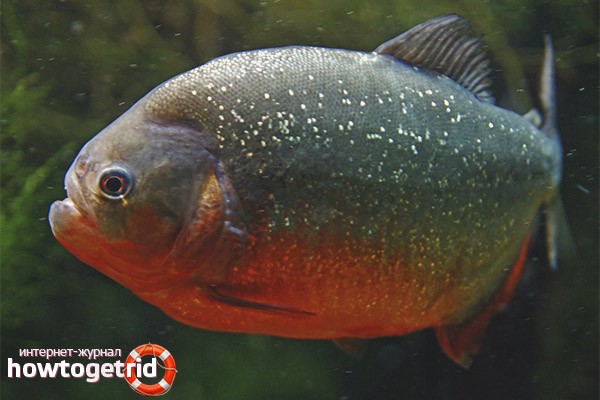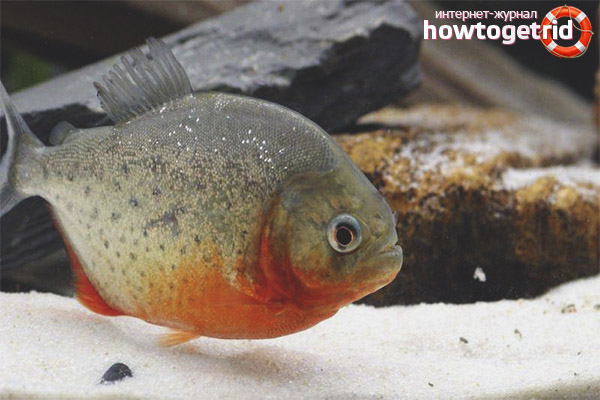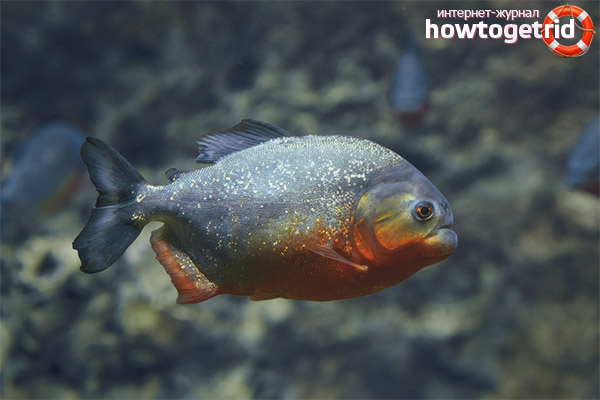The content of the article
The common piranha in Latin is called Pygocentrus nattereri. This fish is also called red piranha. Aquarists have been fond of them for quite some time. Therefore, we can say that the red piranha has a story in this aspect. This species is most common among other piranhas. A lot of them swim in the Amazon and Orinoco rivers.
When a fish grows, it looks very attractive. On her back she has a steel color, the rest of her body is silver. And the throat and stomach are red. The anal fin of the fish has the same color. Among all the piranhas, this is one of the largest representatives. In nature, it can grow up to 33 cm, but with an aquarium content they are smaller.
In nature, they gather in flocks of about 20 individuals. This allows them to hunt more efficiently and not be attacked by larger predators. Red-bellied piranha is the most ferocious of all.
It is unpretentious in food, can live in various conditions. But to start it in your aquarium should be those who have some experience in this matter. If you are not careful, it can bite badly. In addition, their content must maintain good water quality.
Since this fish is a ferocious predator, it is advisable not to hook anyone to it. You can put one fish in the aquarium, but they will feel better in a pack. And here it is important to note that even within the group they can be aggressive. Often there are cases of cannibalism. The flock is led by the largest piranha. She is the first to start eating. If some piranha disputes her leadership, a fight can begin. They often injure each other. They can only be neighbors with their own kind. For example, with such large representatives as the black pacu, and that only in adolescence.
If you want to contain only one piranha, you can do with an aquarium volume of 150 liters. But a flock of piranhas needs more volume. It is very important that the filter is very powerful. Piranhas eat a lot, after them remains a lot of waste.
Living in nature
You can meet her all over South America. There are many in countries such as Brazil, Peru, Colombia. A huge number of piranhas in the Amazon, Paran and many other rivers.
They live in small streams. They can also be found in a pond or lake. They gather in packs to hunt more efficiently. A flock consists of 20-30 individuals. In general, piranha eats everything that is suitable for this. These are both fish and plants.
Description
In nature, it can have a length of about 32 cm. With an aquarium content, these fish are much smaller. They live on average 10 years. But there have been cases when representatives of the species lived much longer.
Their body is powerful, flattened from the sides. You can recognize this fish by its powerful jaw and tail.
Adults have a very beautiful color. Color may vary slightly. Most piranhas have a steel color. The sides are cast in silver. The anal fin of this fish is red in color. Young individuals are not so bright, they are pale silver.
Content Issues

This fish eats almost everything. When kept in an aquarium, there are no special problems. But before you start it, it's better to practice simpler fish. It is important to remember that piranha is a fairly large predator.Even when servicing the aquarium, special care must be taken. Transplanting fish, you can get a serious injury.
Feeding
In nature, these fish eat absolutely any food. They eat everything they catch. This is fish, and a variety of mollusks, and even amphibians. They can eat plant foods - seeds, fruits. If they gather in a large flock, they even attack large prey. Thanks to this, they have earned a reputation as cruel predators. But in nature, they most often feed on carrion, catch insects. They can show particular aggressiveness during a drought, when it becomes difficult to get food. Gathering in packs, they are very aggressively defending themselves from attack.
The main food of piranhas is protein. They can be given fish, frozen seafood, worms, they can eat a mouse. But meat of representatives of this species should not be fed. This will cause obesity. It is important that the water is thoroughly cleaned, as piranhas leave a lot of food leftovers.
Compatibility
Experts argue a lot about whether any other fish can be hooked for piranha. Some argue that this should not be done categorically. Others, on the other hand, give them even small fish that live there successfully. It all depends on the conditions. The volume of the aquarium, the amount of algae, the number and nature of the fish are important. You can add large fish to them, for example, singing catfish or black paca.
If there is a great desire to hook some fish to the piranha, then you can try. They may not touch them at all, but may immediately dine with them.
Content Recommendations
If you plan to contain no more than one piranha, you must purchase an aquarium of 150 liters. If you want them to live in a pack, then you need to buy at least 4 piranhas. To do this, you need an aquarium of 300 liters. The larger it is, the better the fish will feel. It is important to provide them with places in which they can hide. Strange, but they are shy. The best shelter for them would be snags and caves.
It is necessary to replace water, use a filter, control the content of nitrates in order to ensure maximum purity of water.
Protein food, the remains of which remain after each feeding of these fish, quickly deteriorates. This leads to the fact that water is polluted at a high speed. The filter requires more frequent cleaning than with any other fish.
The most interesting thing about keeping this type of fish is watching them. When you study them, you will cease to worry about them. You can identify any emerging problem on time.
Gender differences
Breeding
It is important that the aquarium is in a quiet place where no one will bother piranhas. In order for the fish to be compatible with each other, it is necessary that they belong to a formed school. Water must be clean and warm. The couple should have plenty of space so that they can designate their territory.
First, the couple selects a place, zealously guards it. They acquire a darker color, begin to build a nest. The female lays eggs. The male fertilizes her and begins to guard.
Caviar has an orange color. It begins to peck in a few days. Two days later, fry begin to emerge, which need to be deposited. The fry grow very intensively and immediately begin to eat a lot.
Video: Red Bellied Piranha











Submit